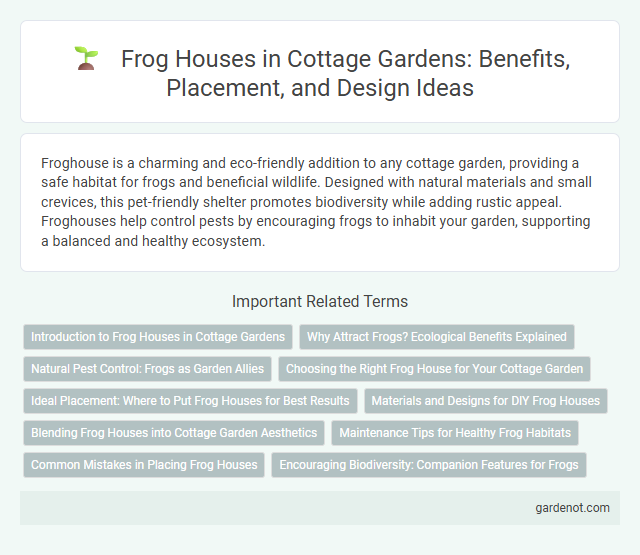Froghouse is a charming and eco-friendly addition to any cottage garden, providing a safe habitat for frogs and beneficial wildlife. Designed with natural materials and small crevices, this pet-friendly shelter promotes biodiversity while adding rustic appeal. Froghouses help control pests by encouraging frogs to inhabit your garden, supporting a balanced and healthy ecosystem.
Introduction to Frog Houses in Cottage Gardens
Frog houses in cottage gardens provide essential shelter for amphibians, promoting biodiversity and natural pest control. These small, carefully designed structures mimic natural hiding spots, offering frogs protection from predators and harsh weather conditions. Incorporating frog houses enhances the ecological balance of cottage gardens by supporting healthy frog populations.
Why Attract Frogs? Ecological Benefits Explained
Attracting frogs to a cottage garden enhances natural pest control by reducing insect populations such as mosquitoes, aphids, and snails, promoting a healthier plant environment. Frogs serve as important bioindicators, signaling a balanced and pollution-free ecosystem essential for biodiversity in garden habitats. Providing water features and shelter encourages frog habitation, contributing to ecological harmony and supporting native wildlife conservation.
Natural Pest Control: Frogs as Garden Allies
Froghouses provide essential shelter for frogs, natural predators of garden pests such as slugs, mosquitoes, and beetles, enhancing the ecosystem's balance. By attracting and protecting amphibians, froghouses support sustainable pest control without chemical pesticides, promoting a healthier cottage garden environment. Strategic placement near moist areas and dense vegetation maximizes frog activity, boosting their effectiveness as biological pest controllers.
Choosing the Right Frog House for Your Cottage Garden
Selecting the right frog house for your cottage garden enhances biodiversity by providing a safe, moist habitat for native amphibians. Choose shelters made from natural materials like wood or terracotta, ensuring they have damp, shaded locations near water sources to maintain ideal humidity levels. Proper placement beneath leafy shrubs or among dense ground cover promotes frog activity, aiding pest control and supporting the garden's ecological balance.
Ideal Placement: Where to Put Frog Houses for Best Results
Position frog houses in shaded, moist areas near water sources like ponds or streams to create an inviting habitat for amphibians. Placing them under dense vegetation or leafy shrubs fosters protection from predators and extreme weather. Ensure the ground is uneven and covered with natural mulch to maintain humidity and encourage frog habitation.
Materials and Designs for DIY Frog Houses
DIY frog houses often utilize natural, non-toxic materials such as untreated wood, bamboo, and natural stone to create safe and sustainable habitats. Designs emphasize small, shaded structures with moisture-retaining features like moss-lined interiors and ventilation holes to maintain humidity. Incorporating sloped roofs and camouflage patterns helps integrate the frog house seamlessly into cottage garden ecosystems and provides shelter from predators.
Blending Frog Houses into Cottage Garden Aesthetics
Froghouses seamlessly blend into cottage garden aesthetics by utilizing natural materials such as reclaimed wood and stone, which complement the rustic charm of flowering borders and climbing roses. Positioning froghouses near water features or damp, shaded areas mimics frogs' natural habitats, enhancing both garden biodiversity and visual appeal. These small refuges support amphibian populations while reinforcing the enchanting, whimsical character typical of cottage garden designs.
Maintenance Tips for Healthy Frog Habitats
Froghouses require regular cleaning and fresh water to prevent algae buildup and maintain a healthy environment for amphibians. Planting native aquatic vegetation around the froghouse offers shelter and breeding grounds, enhancing frog well-being. Monitoring water quality and avoiding pesticides ensures a toxin-free habitat that supports frog populations in cottage gardens.
Common Mistakes in Placing Frog Houses
Placing frog houses in shaded, moist areas with natural ground cover is essential for attracting amphibians and supporting their habitat. Common mistakes include positioning frog houses in direct sunlight or on hard surfaces like concrete, which can cause overheating and deter frogs from using the shelter. Ensuring the frog house is partially buried and near water sources increases its effectiveness in providing a safe refuge for garden frogs.
Encouraging Biodiversity: Companion Features for Frogs
Froghouses provide essential shelter and breeding sites that attract amphibians, supporting local biodiversity in cottage gardens. Incorporating water features, native plants, and damp, shaded spots nearby creates a thriving habitat for frogs and other beneficial wildlife. These companion elements enhance ecological balance by promoting natural pest control and pollination.
Froghouse Infographic

 gardenot.com
gardenot.com